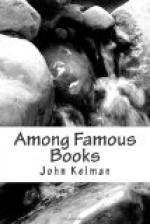2. Body and Spirit.—Souls are “rendered visible in bodies that took shape and will lose it, melting into air.” Thus bodies, and not spirits, are the true apparitions, the souls being the realities which they both reveal and hide. In fact, body is literally a garment of flesh—a garment which the soul has for a time put on, but which it will lay aside again. One of the greatest of all the idolatries of appearance is our constant habit of judging one another by the attractiveness of the bodily vesture. Many of the judgments which we pass upon our fellows would be reversed if we trained ourselves to look through the vestures of flesh to the men themselves—the souls that are hidden within.
The natural expansion of this is in the general doctrine of matter and spirit. Purely material science—science which has lost the faculty of wonder and of spiritual perception—is no true science at all. It is but a pair of spectacles without an eye. For all material things are but emblems of spiritual things—shadows or images of things in the heavens—and apart from these they have no reality at all.
3. Society and Social Problems.—It follows naturally that a change must come upon our ways of regarding the relations of man to man. If every man is indeed a temple of the divine, and therefore to be revered, then much of our accepted estimates and standards of social judgment will have to be abandoned. Society, as it exists, is founded on class distinctions which largely consist in the exaltation of idleness and wealth. Against this we have much eloquent protest. “Venerable to me is the hard hand; crooked, coarse; wherein notwithstanding lies a cunning virtue, indefeasibly royal, as of the Sceptre of this Planet. Venerable too is the rugged face, all weather-tanned, besoiled, with its rude intelligence; for it is the face of a Man living man like.” How far away we are from all this with our mammon-worship and our fantastic social unrealities, every student of our times must know, or at least must have often heard. He would not have heard it so often, however, had not Thomas Carlyle cried it out with that harsh voice of his, in this and many others of his books. It was his gunpowder, more than any other explosive of the nineteenth century, that broke up the immense complacency into which half England always tends to relapse.
He is not hopeless of the future of society. Society is the true Phoenix, ever repeating the miracle of its resurrection from the ashes of the former fire. There are indestructible elements in the race of man—“organic filaments” he calls them—which bind society together, and which ensure a future for the race after any past, however lamentable. Those “organic filaments” are Carlyle’s idea of Social Reality—the real things which survive all revolution. There are four such realities which ensure the future for society even when it seems extinct.




